PIPING SUPPORT GUIDE
Please follow our guide to find out how to correctly attach your piping network to surrounding structures
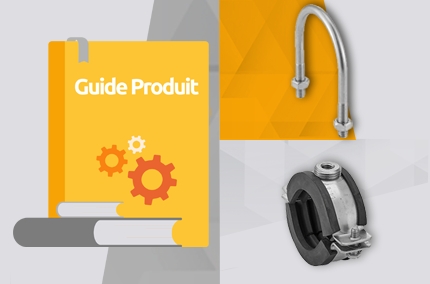
Our selection of piping support products complements our range of connectors , pipes and accessories .
Our piping support range allows you to fix and secure your piping network to its surrounding environment.
This guide will help you to define your bracket , fixing collar and other support element requirements
1. Brackets
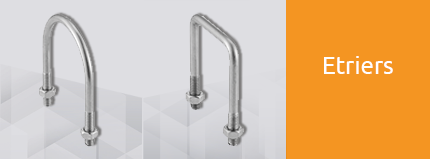
>> Brackets for metric pipes | model 72112
>> Brackets for square pipes | model 72110
Other available models : brackets for ISO pipes (model 72111), long threaded brackets for ISO pipes (model 72105), long threaded brackets for metric piping (model 72106).
Our brackets are supplied with the 2 nuts that you will need for their assembly.
The function of a bracket is to fix a pipe to its surrounding environment via a wall, ceiling or floor support.
This is a good alternative for piping systems that carry light loads and which only vibrate a little bit, or not at all.
They can also be used as guides or flanges in certain piping networks.
1.1 Piping support selection
You should consider several criteria when you are choosing your piping supports (including brackets) :
First, your piping's standard (ISO or metric) and shape (square or round) will influence your choice.
Then, secondly, you will need to consider the material that it is made from :
- You need to carefully consider the environment where you will fix it (you will need to take special care in aggressive environments such as marine or chemical industry environments, where the use of A4 stainless steel is recommended).
We propose A2, A4 (for maritime or chemical industry usage) and zinc-coated stainless steel in our product range so that you can chose the bracket that is most suitable for your usage environment.
- You need to know what piping material will be directly in contact with the bracket (to avoid the occurrence of galvanic corrosion).
- Galvanic corrosion appears when two different metals are in contact with each other. This phenomenon is the result of the difference in electrode potential between these two metals.
The less 'noble' metal will degrade and this will cause galvanic corrosion. Other factors can also cause this phenomenon such as humidity, temperature etc.
Here is a table which summarises the galvanic corrosion potentials of certain metals.
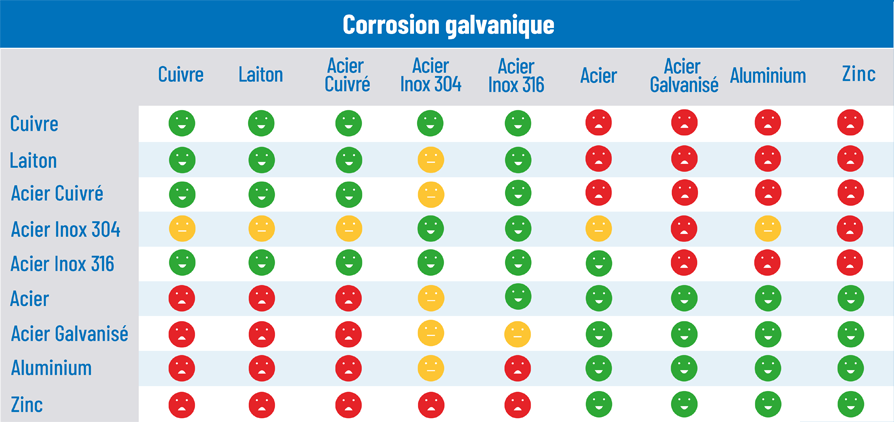
1.2 Fixing systems
Different bracket fixing systems are available. You can either screw these directly on to a rail or a wall support . You can also choose a bracket mounting plate option.
PLEASE NOTE: you can use the following products instead of brackets :
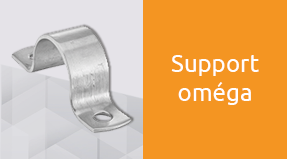
Omega pipe holder | model 72090 :
This is a good alternative to brackets. This pipe holder has holes in it so that it can be directly fixed into concrete using wedge anchors.
An Omega pipe holder can also be used with hammer head bolt fixings (model 72129 et model 72184 ) so that you can tighten it quickly and easily onto a rail.
It has the same functions as a bracket, however these pipe holders are assembled over a larger load-bearing surface.
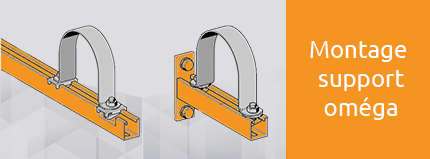
Beam clamp for C-profile rails | model 72204 :
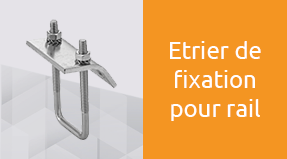
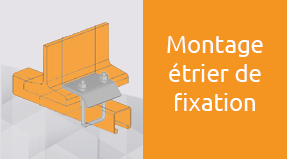
Standard beam clamp assembly on a C-profile rail (diagram on the right)
You can use this clamp for strong fixing on stainless steel or metallic constructions without any drilling or welding.
2. Pipe holders
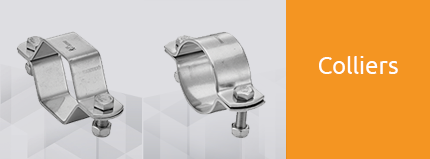
You can use pipe holders to fix piping onto its surrounding environment or a support structure.
We propose pipe holders with many different alternatives which make them extremely easy to assemble: single screw closing (and one articulation) and/or double screw closing, with or without a clamping shaft, round or hexagonal in shape.
We propose many different types of pipe holders :
- Hexagonal pipe holders (model 72117), which you can use to preserve the polished external surface of a pipe and avoid retention zones . This is mainly used in the food and beverage sector.
- Round pipe holders (model 72113), this is a standard piping support product . This is recommended for use in industrial or "utilities" networks.
- Round or hexagonal pipe holders with fixing shaft (model 72115) and with 2 screws (model 72140 ) can make your piping installation even easier.
2.1 Pipe holder selection
You need to consider a number of different factors when you choose a pipe holder :
1. Fluid temperature :

Standard pipe holders with (EPDM) insulation can withstand a fluid temperature between -30°C and +120°C .
But above or below this temperature range you should use more specific pipe holders.
We propose several pipe holder models which are specifically designed to withstand the cold, with their foam insulating shells, that can be used down to -180°C (model 72177 and model 72178 ) and high temperature pipe holders | model 72175.
2. Maximum allowed load
The maximum allowed load is defined by the weight of the piping that the pipe holder will need to carry.
You will need to take into account the weight of your piping network and choose either a pipe holder from our heavy-duty range (model 72125) for heavy loads or from our light-duty range model 72113 (for the lightest weights).
The width and thickness of the pipe holder is different for these two ranges.
3. Materials and piping dimensions
Your choice of material is a very important point. This is because the two materials that will be in contact must be compatible to make sure that there will not be any galvanic corrosion.
For example, if stainless steel is in contact with galvanised (zinc-coated) steel then this will lead to corrosion in the long term. The same thing will happen if stainless steel is in contact with aluminium.
However, protected pipe holders can come into contact with other materials without any risk of corrosion.
The internal diameter of the pipe holder must correspond to the pipe's outer diameter so that the pipe holder can be tightened correctly.
4. Usage environment
You need to take into account the process environment that your pipe holder will be used in, i.e. will the piping be located inside or outside, will the surrounding environment be aggressive or not.
You need to take into account the piping material, to make sure that the two materials that are in contact will not corrode, in the same way as if you were choosing a bracket.
5. Specific requirements
Some of our pipe holders are adapted for specific requirements :
- If your piping system vibrates a lot, you can choose one of our anti-vibration pipe holders according to the load that they will need to support (model 72114 light-duty range | model 72126 heavy-duty range).
- Isophonic collars are recommended for piping that vibrates and makes a lot of noise (model 72172 two screws | model 72175 one screw).
- If you need to reduce vibrations and noise, ensure high resistance to chemical products, weather or UV light (for welding below the pipe holder), you can use pipe holders made from polypropylene (model 72121 without reinforcing plate | model 72122 with reinforcing plate) as they are suitable for all of these requirements.
- You should choose model 72179 (or a pear collar ) for creating sprinkler networks and this can be associated with model 72176 which has been specifically fire tested.

2.2 Fixation type
- Threaded pipe holders: these can be used with a threaded shaft (model in 304 stainless steel: 214650 and 316 stainless steel: 414650 ) due to their female threading and can be connected to a rail or a wall support so that they can be attached to a wall, floor or ceiling etc.
- Pipe holders without threading: these can be welded directly onto a support: e.g. a fixing rail, a wall bracket or a mounting plate/angle. Different types of fixing :
> Use with a bracket
> Use with a mounting plate for polypropylene or polyamide pipe holders (for welding)
- Pipe holders with fixing shaft to be welded: these can be used to offset a pipe holder from its support.
3. Supports
You can use many different elements to support your piping network. First, you need to check your support's profile (e.g. strut or C-profile) and also the material it is made from (e.g. 316L stainless steel, ultraprotect steel, galvanised (zinc-coated) steel or hot dip galvanised steel).
Here is a selection of the most commonly used models :
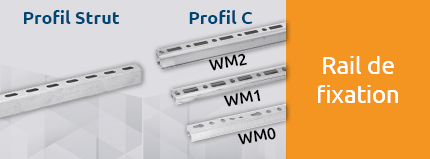
1 - Strut-profile fixing rails (model 72127) | C-profile fixing rails (model 72198) : these can be used to form the base of an installation, they can be fixed in parallel to a wall or ceiling using concrete screws/screw plugs, see the building fixings category
A rail can be used with a wall bracket to extend its support line and build up an installation's base. We propose 3 types of C-profiles, with different cross-sections: WM0, WM1 WM2.
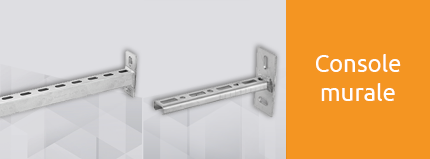
2 - Strut-profile wall brackets (model 72131) | C-profile wall brackets (model 72200) can also be used for an installation's base.
A wall bracket can be fixed at right angles to a wall using concrete screws or plugs, see the building fixings category
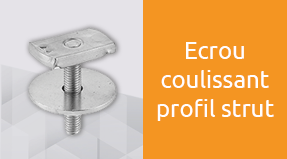
3 - Slide nuts for Strut-profile rails | model 72119, allow a threaded shaft to be quickly connected to a rail that is connected to a pipe holder.

4 - U-shaped connectors for Strut-profile rails (model 72187) / T- or X-shaped connectors (model 72188) / C-profile fixing brackets (model 72003) | Strut-profile fixing brackets (model 72203) /
Cross connectors for Strut-profiles (model 72190) are all elements which allow you to construct things in different ways e.g. by connecting a threaded shaft to a rail or by connecting two rails together etc.

5 - Brackets (model 72192) / rail clips (model 72193) / fixing clips (model 72194)
You can use these products with a Strut profile to connect a rail to a metallic beam or any other foundation/fixing support.
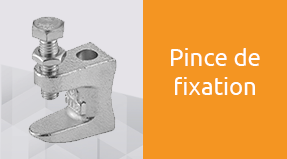
6 - Fixing clamps (model 72181) should always be used with a safety strap. You can assemble these in a large number of different ways :
1. Metal rail and beam
2. Metal beam, threaded shaft and pipe holder
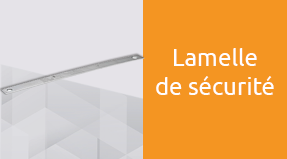
7- The safety strap needs to be used with metallic beam fixing clamps (model 72182).
You should assemble the beam fixing clamps with a safety strap (this is mandatory for piping > Ø 65mm according to the VdS standard).
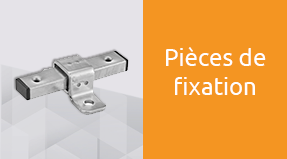
8 - Slide fixing parts that allow for dilatation (model 72196) allow a pipe holder to move in translation so that it can follow and support movements caused by piping dilation.
These parts can be assembled flat, suspended or directly fixed onto a building or rail mounting.
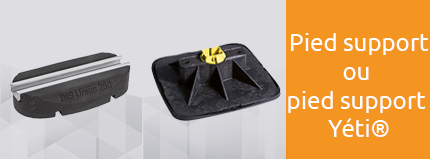
9 - You can use support stands, Yéti® or Bigfoot support stands (model 72206 and 72207) to assemble vertical or even horizontal rails. You can use these to reduce vibrations and spread-out loads. They also prevent slipping.
Do you need any more information ?
>> Please click here to consult our piping selection guide
>> Please click here to find the piping models that are most commonly used by our customers
>> lease contact us to find out more on 0033 4 78 90 48 22 or by filling in our request for information form here
�
